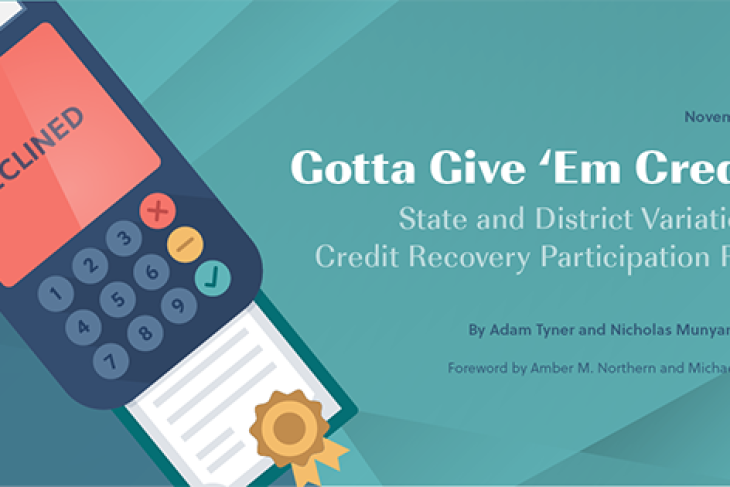Credit recovery, or the practice of enabling high school students to retrieve credits from courses that they either failed or failed to complete, is at the crossroads of two big trends in education: the desire to move toward “competency based” education and a push to dramatically boost graduation rates.
Balancing these competing demands is a challenge, but balance we must because, under ESSA, states are required to factor graduation rates into their high school accountability plans. That provides an unintended incentive for schools to play games with graduation requirements, which underscores the need to keep credit recovery from turning into a total end run around actual learning.
Authored by Fordham’s Associate Director of Research Adam Tyner and Research Associate Nicholas Munyan-Penney, Gotta Give 'Em Credit: State and District Variation in Credit Recovery Participation Rates examines whether and where potential misuse of credit recovery may be occurring. Specifically, it answers three questions:
- How many high schools have active credit recovery programs, and are some types of schools more likely than others to have them?
- How many students are enrolled in credit recovery?
- To what extent do schools enroll large shares of their students in credit recovery, and is that more common in certain types of schools?
Using newly released credit recovery data from the Office for Civil Rights and demographic data from the National Center for Education Statistics, the analysis generates results at the national, state, and local levels. Namely:
- Most high schools have credit recovery programs, although they are far less common in charter schools.
- While the presence of credit recovery programs is generally not related to school poverty levels, schools with many minority students are slightly more likely to have active programs.
- Credit recovery programs are less common in smaller schools. The likelihood of having an active program climbs steadily as enrollment rises to 1,250 students.
- In high schools with active credit recovery programs, an average of 8 percent of students participate. However, nearly one in ten schools enrolls 20 percent or more of its students.
- Higher enrollment in credit recovery is more common in large and urban schools, as well as in charter schools and schools with higher proportions of poor and minority students.
We derive the following takeaways from these findings:
- Adopt the old adage of trust but verify. Until we have better data than are presently available, we shouldn’t assume that credit recovery programs are of high quality.
- Target the outliers. Districts and schools (both traditional and charter) with higher rates of students participating in credit recovery warrant scrutiny. The potential to abuse this kind of program is high—and highest when there’s no external check on students’ mastery of the material.
- Adopt the recommendations put forth by the report’s authors. This includes collecting additional data about credit recovery programs at the federal and state levels, such as whether courses are taken in person or online and the name of the curriculum or software program used; adopting formal state guidelines for credit recovery programs, especially as it pertains to eligibility and vetting of courses; and using external assessments to hold students and schools accountable.
- And finally, in the absence of an external check on quality, adopt the ounce-of-prevention rule. Stipulate, as some states already do, that students must have previously failed the original course to be eligible for credit recovery, or require students to achieve a minimum score in the original course so that they aren’t starting from scratch with new material.
Having more than one way to demonstrate mastery of content in high school is laudable, but educators and policymakers need to ensure that credit recovery programs meet expectations for quality and include sufficient safeguards to protect students from misuse. Otherwise, the incentives to propel unprepared adolescents towards graduation will outweigh those that advance the challenging but noble work of sufficiently educating them.

